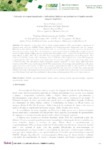Use este identificador para citar ou linkar para este item:
http://www.alice.cnptia.embrapa.br/alice/handle/doc/1073559Registro completo de metadados
| Campo DC | Valor | Idioma |
|---|---|---|
| dc.contributor.author | LEIVAS, J. F. | pt_BR |
| dc.contributor.author | TEIXEIRA, A. H. de C. | pt_BR |
| dc.contributor.author | SILVA, G. B. S. da | pt_BR |
| dc.contributor.author | GARCON, E. A. M. | pt_BR |
| dc.date.accessioned | 2017-08-03T11:11:11Z | pt_BR |
| dc.date.available | 2017-08-03T11:11:11Z | pt_BR |
| dc.date.created | 2017-08-03 | pt_BR |
| dc.date.issued | 2017 | pt_BR |
| dc.identifier.citation | In: SIMPÓSIO BRASILEIRO DE SENSORIAMENTO REMOTO, 18., 2017, Santos. Anais... Santos: Inpe, 2017. | pt_BR |
| dc.identifier.uri | http://www.alice.cnptia.embrapa.br/alice/handle/doc/1073559 | pt_BR |
| dc.description | The objective in this study was to obtain evapotranspiration (ET) and biophysics parameters at irrigated areas using the SAFER (Simple Algorithm For Evapotranspiration Retrieving) and the Penman-Monteith models without using the thermal band, with the aim of enhancing spatial resolution and therefore detecting more surface details. We collected data from meteorological stations and RapidEye satellite images (5 meters) of Jaíba (North of Minas Gerais) and Petrolina (Pernambuco state), located at in the São Francisco river basin, Brazil, in 2011, 2012, 2013, and 2014. The average daily evapotranspiration rate in Petrolina for 2011 scene was of 0.47±1.14 mm, with a maximum value of 6.96 mm at the irrigated areas. In the 2014 image the evapotranspiration (ET) rate reached values higher than 7.6 mm at the irrigated areas, and average daily values of 0.64±1.43 mm. The atmosphere's higher evaporative demand caused ET to reach values higher than those observed in the 2011 scene, maybe due to the El Niño phenomenon, which reduces the rainfall rates at the study region and causes water scarcity. In 2013, daily average evapotranspiration (ET) of Jaiba was 0.43 ± 0. 96 mm and maximum value was 6.11 mm. In 2014, the average daily ET value was 2.19 ± 2.01mm. The results obtained enabled evaluating evapotranspiration during periods of severe drought with the advantage of not requiring the use of the thermal band, and thus contributing to the planning and management of the use of water resources. | pt_BR |
| dc.language.iso | por | pt_BR |
| dc.rights | openAccess | pt_BR |
| dc.subject | Modelo agrometeorológico espectral | pt_BR |
| dc.title | Obtenção de evapotranspiração e indicadores hídricos em perímetros irrigados usando imagens RapidEye. | pt_BR |
| dc.type | Artigo em anais e proceedings | pt_BR |
| dc.date.updated | 2017-08-03T11:11:11Z | pt_BR |
| dc.subject.thesagro | Sensoriamento Remoto | pt_BR |
| dc.format.extent2 | p. 4590-4596. | pt_BR |
| riaa.ainfo.id | 1073559 | pt_BR |
| riaa.ainfo.lastupdate | 2017-08-03 | pt_BR |
| dc.contributor.institution | JANICE FREITAS LEIVAS, CNPM; ANTONIO HERIBERTO DE C TEIXEIRA, CPATSA; GUSTAVO BAYMA SIQUEIRA DA SILVA, CNPM; EDLENE APARECIDA MONTEIRO GARCON, CNPM. | pt_BR |
| Aparece nas coleções: | Artigo em anais de congresso (CNPM)  | |
Arquivos associados a este item:
| Arquivo | Descrição | Tamanho | Formato | |
|---|---|---|---|---|
| 4826.pdf | 654.67 kB | Adobe PDF |  Visualizar/Abrir |









